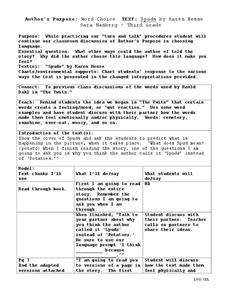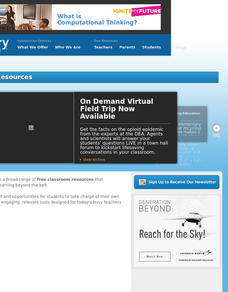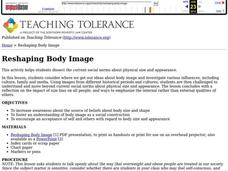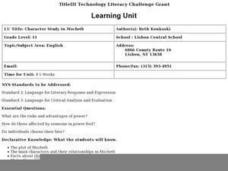Curated OER
No is No, Si is Yes
Third graders match the body part words in Spanish to a picture. They receive a picture of a human with lines coming from its feet, hands, and arms. Students use a word bank, to write the Spanish word that corresponds to the picture. ...
Curated OER
Word Purpose
Third graders chunk text while reading it. For this language arts lesson, 3rd graders determine the author's purpose for calling certain things the names they are called like spuds for potatoes. Students discuss how words affect the...
Curated OER
Islam & Islamophobia
Young scholars explore the concept of Islamophobia. In this Islam lesson, students watch an online video to understand religious dress, Muslim practices, and the discrimination facing American Muslims. Young scholars disucss their...
Curated OER
Mind Over Matter: How Does the Brain Work
Students research previous attempts by scientists to discover the ways in which the brain works, design and conduct an experiment to illustrate current research and present their findings to the class.
Curated OER
Healthy Relations
Students draw on their own experiences with health care to create educational skits to better doctor-patient relationships. For homework, they create guidelines and write recommendations for an appropriate government role.
Curated OER
Tunisia to Egypt & Beyond: Freedom & Democracy?
Students examine democratic values. In this current events lesson, students watch video clips about rebellions on Tunisia and Egypt. Students respond to the provided discussion questions and participate in a critical thinking activity on...
Curated OER
Be a Good Friend
Students discover characteristics of a good friend. In this social skills lesson plan, students read Clifford's Manners and discuss ways Clifford used his manners in the story. An activity that rewards students for modeling being...
Curated OER
Haiti: Still in Crisis, but No Longer in the News
Pupils study the Haitian crisis and learn about the needs and ways to help the situation. In this Haitian crisis lesson, students study the Maslow's "Needs Pyramid". Pupils study the media coverage of the earthquake and then answer...
Curated OER
WWI Propaganda
Students research propaganda from World War I and compare it with propaganda used today. They define propaganda and discuss the five techniques used by advertisers, conduct Internet research, and create a project that compares how...
Curated OER
Reshaping Body Image
Students determine how beliefs about body size and shape are shaped. They develop ideas about the acceptance of self and others with regard to body size and appearance by working in small groups. They view and discuss a PowerPoint...
Curated OER
Reshaping Body Image
Students view images and write responses based on their impressions. In this body image lesson, students brainstorm how body image is influenced culturally and participate in a small group discussion on these influences. Students view...
Curated OER
Clifford the Big Red Dog: Work Together
Students explore the concept of cooperation. In this literature lesson plan, students read Clifford's Busy Week and discuss teamwork as they create "Lost and Found" journals and build paper trains.
Curated OER
Reading Keep the Lights Burning, Abbie
Students explore Keep the Lights Burning, Abbie. In this reading comprehension lesson, students answer questions and define vocabulary words before, during, and after reading the book Keep the Lights Burning, Abbie.
Curated OER
Character Study in Macbeth
Eleventh graders analyze a Shakespeare soliloquy by writing a prose summary of it. They keep a character journal, following one character through the play and analyzing what the character does and says, as well as, might have done or...
Utah Education Network
Uen: 2nd Grade Act. 11: Character Sketch
This lesson engages students in describing the main character from Patricia Palacco's book, My Rotten Redheaded Older Brother. Students will analyze a picture of the main character and the teacher will write all of the students'...
SMART Technologies
Smart: Show Don't Tell
This lesson provides students with examples of Show, Don't Tell and connected emotions including an emotions and feelings chart. It gives them an opportunity to practice the concept as well.

















